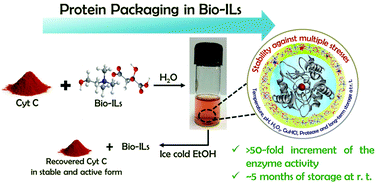Long-term protein packaging in cholinium-based ionic liquids: improved catalytic activity and enhanced stability of cytochrome c against multiple stresses†
Abstract
There is considerable interest in the use of structurally stable and catalytically active enzymes, such as cytochrome c (Cyt c), in the pharmaceutical and fine chemicals industries. However, harsh process conditions, such as temperature, pH, and the presence of organic solvents, are the major barrier to the effective use of enzymes in biocatalysis. We demonstrate the suitability of cholinium-based ionic liquids (ILs) formed by the cholinium cation and dicarboxylate-based anions as potential media for enzymes, in which remarkable enhanced activity and improved stability of Cyt c against multiple stresses were obtained. Among the several ILs studied, an exceptionally high catalytic activity (>50-fold) of Cyt c was observed in the aqueous solutions of cholinium glutarate ([Ch][Glu]; at 1 : 1 weight ratio of IL : H2O) compared to the commonly used phosphate buffer solutions (pH 7.2), and >25-fold compared to the aqueous solutions of cholinium dihydrogen phosphate ([Ch][Dhp]; 1 : 2 weight ratio of IL : water)—the best known IL for long term stability of Cyt c. The catalytic activity of the enzyme in the presence of ILs was retained against several external stimuli, such as chemical denaturants (H2O2 and GuHCl) and temperatures of up to 120 °C. The observed enzyme activity is in agreement with its structural stability, as confirmed by UV–vis, circular dichroism (CD), and Fourier transform infrared (FT-IR) spectroscopy. Taking advantage of the multi-ionization states of di/tri-carboxylic acids, the pH was switched from acidic to basic by the addition of the corresponding carboxylic acid and choline hydroxide, respectively. The activity was found to be maximum at a 1 : 1 molar ratio of [Ch][carboxylate], with a pH in the range from 3 to 5.5. Moreover, it was found that the cholinium-based ILs studied herein protect the enzyme against protease digestion and allow long-term storage (at least for 21 weeks) at room temperature. An attempt by molecular docking was also made to better understand the efficacy of the investigated cholinium-based ILs towards the enhanced activity and long term stability of Cyt c. The results showed that dicarboxylate anions interact with the active site's amino acids of the enzyme through H-bonding and electrostatic interactions, which are responsible for the observed enhancement of the catalytic activity. Finally, it is demonstrated that Cyt c can be successfully recovered from the aqueous solution of ILs and reused without compromising its yield, structural integrity and catalytic activity, thereby overcoming the major limitations in the use of IL–protein systems in biocatalysis.



 Please wait while we load your content...
Please wait while we load your content...